About six weeks ago I bought a Lensbaby Composer, and although I released an Initial Impressions review here on my blog straight away, having now had a chance to take it through its paces a little more, here’s a more in-depth review of what I’ve found to be more than a lens. In some circumstances it can be the perfect aid to photographic creativity.
First I’ll touch on some my initial impressions from my first blog post. The first thing that struck me when I opened the box is that the Lensbaby Composer is big and heavy. I don’t mean heavy like a big L lens, but it’s got a good weight. I have a first generation Lensbaby, and a Lensbaby 2.0 and never really like the way they looked on the camera. I use big 5D and 1Ds series cameras, and always have the battery grip on the 5D. To me, the old Lensbabies just looked a little bit too small on the camera, and never felt balanced. This is really not the case with the Composer. It feels very similar in size, weight and overall balance, to having the Canon EF 50mm F1.4 or F1.8 lens on the camera.
One of the other things I noticed quickly is that the Lensbaby Composer has a metal mount. I should have noticed this from the pictures I’ve seen of it online, but I hadn’t. This was another great surprise. Overall, the build just feels great, right down to the knurling etc on the focus ring, and the second ring used to lock the movable Lensbaby head in place.
You can see the metal mount in the photo below as well as the dedicated lens case that you can also buy as an option. The case is very well made and well worth the additional $15 in my opinion.

Lensbaby Composer with case and aperture rings etc.
The other thing I never liked about the old Lensbabies was the softness of the images. I read on the Lensbaby Web site that the Composer came fitted with the multi-coated Double Glass Optic, from the Optic Swap System, which allows you to change the optics to use the Composer with various lenses. I didn’t buy any other Optics this time. I figured I’d see how much I use the composer first, and also, I wanted to check the build quality, though that’s now behind me.
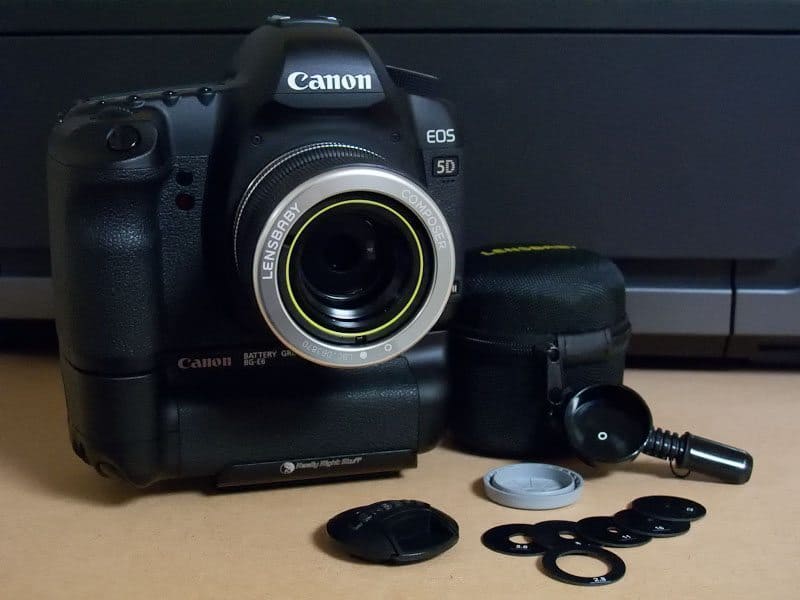
Lensbaby Composer on the 5D Mark II
One of the other things that I find geeky about the Lensbaby, in a nice way of course, is that to change the aperture you have to literally change the aperture ring in the front of the lens. As you can see above, the Lensbaby comes with a little plastic holder with a magnet that looks a little bit like a small plastic frying pan with a cap to keep the aperture rings safely inside. You use the magnet to remove the current aperture ring, and then drop in your required aperture ring size, and it is sucked in and held in place by the magnets around the front of the lens. Without any aperture ring the Lensbaby Composer has an aperture of F2, and then you have all the rings for full stops from F2.8 down to F22.
I couldn’t wait to try the Composer out to see just how sharp it was with the new double glass elements, so I grabbed my tripod on that first evening and headed out into a thunder storm to give it a try. The following two images were the results of this tiny excursion into the elements in Tokyo. The first image is number 2287, of the roof tops in the storm. This was taken with the F4 aperture ring installed. Here I lined up the sweet spot, which is where the lens is sharp, with the building on the horizon. I used an ISO of 50 for an 8 second exposure, and the clouds are nicely lit because of the lightening that struck while the shutter was open.
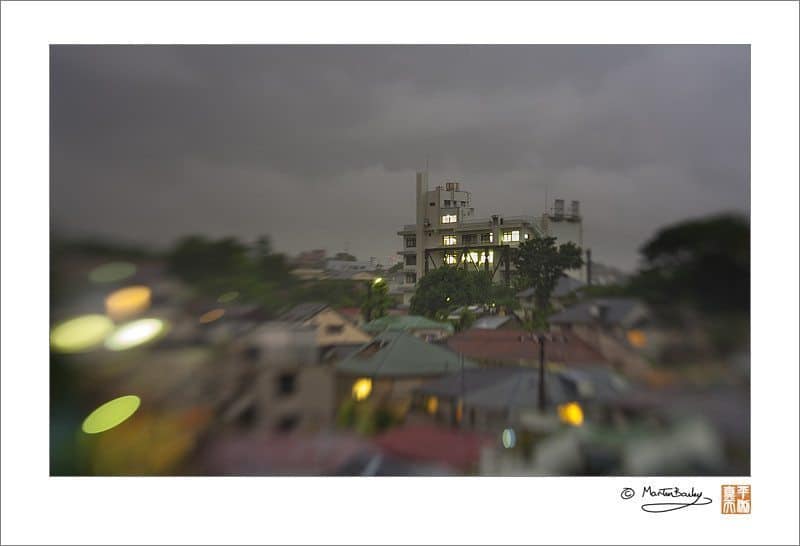
Tokyo Rainstorm with Lensbaby Composer @ F4.0
I was pretty amazed to see that on closer inspection of the images on my PC later, the area inside the sweet spot was incredibly sharp. The Lensbaby Composer with the Double Glass Optic is as sharp as many of my Canon L lenses. I am very impressed with the image quality. You can also see from this first image that the areas outside of the sweet spot flow off to the edges of the frame really nicely.
So that you can check the sharpness of the lens for yourself, here is a 100% crop of the sharp part of the above image.

100% crop @ f4.0, 8 second exposure
I wanted to check if the glass was still sharp at F2.8, so I also shot a test image with the F2.8 aperture ring installed, which I uploaded to my gallery as image 2288. Still at ISO 50, the below image was shot with a one second exposure. The first tip for using a Lensbaby here is that sometimes, the most obvious subject in the frame is not always the best one to focus the sweet spot on. Here I moved the sweet spot down onto the rooftops of the houses in the foreground, and allowed the more obvious building on the hill to go out of focus. This works too I think, though it probably comes down to person preference which one you think is the better image. Experiment though by all means. The Lensbaby is in my mind as much a creative tool as it is a lens. Just looking through it and playing is a major part of the fun of this system.
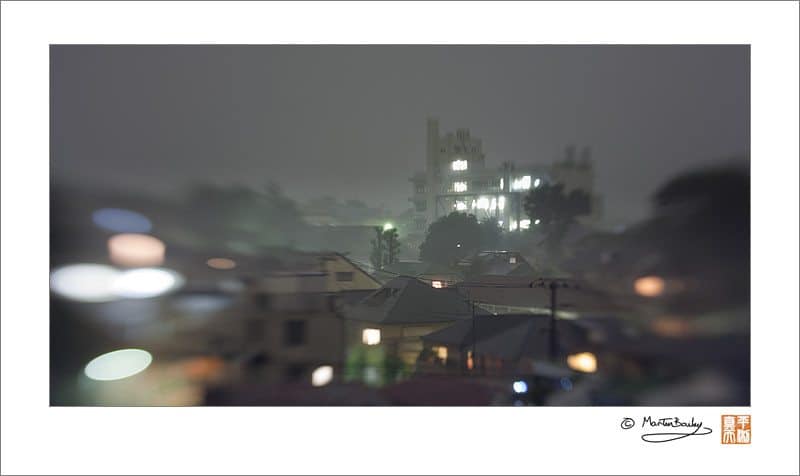
Tokyo Rainstorm with the Lensbaby Composer @ F2.8
Again, here’s a 100% crop of this image so that you can see how sharp it is at F2.8. I am really impressed with this lens, I can tell you.

100% crop @ f2.8, 1 second exposure
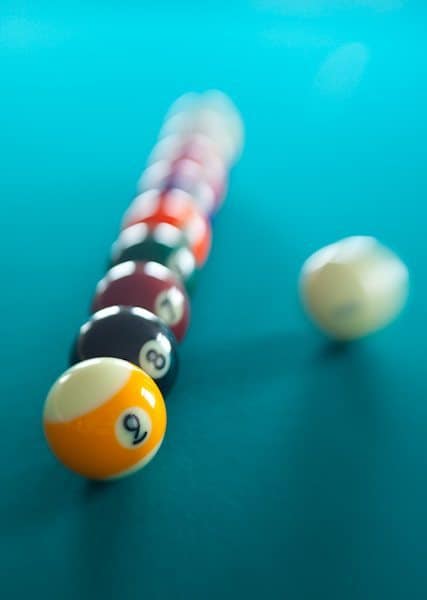
Billiard Balls with Lensbaby @ F2.0
I realized while preparing for this review that still didn’t yet have any images shot at F2.0, so I shot some billiard balls (right) to see how the Lensbaby Composer fared wide open. I focused on the 9 ball in the front of the line, and we can see how this has basically enabled me to pretty much get the nine-ball in focus, but then everything else is nicely blurred. Because the Lensbaby has a sweet spot of focus, rather than a line of depth-of-field, parallel to the film plane or your digital sensor, even the felt of the billiard table has very little texture out outside of the immediate surroundings of the nine-ball.
We’ll look at a 100% crop in a moment, but I did want to touch on a technique that I’m perfecting for aligning the sweet spot with your chosen subject within the frame. I have to admit, I don’t find aligning that sweet spot particularly easy, especially when shooting hand-held, as I was here. I shoot most of my images with a tripod, and when using a tripod, especially with live-view, it’s a lot easier. You can move things around while viewing on the LCD, tweak the focus, and then shoot. When shooting hand held though, things are a little more hit and miss, so as I get more practice with the lens, here’s what I’m finding myself doing.
Basically, I straighten up the Lensbaby Composer a little, if it was bent off center that is, and I focus roughly on the subject that I want to align the sweet spot too, then recompose, if the subject is off center, which is usually is. Then I start to twist the Lensbaby around, making sure that I’ve loosened the locking ring at the base of the lens, so that I can freely move it around. As I find my intended main subject in the frame, looking through the viewfinder by the way, I move the sweet-spot around it a little, as it’s easier to see if you have the sweet-spot over your subject when it starts to go back out of focus as you go a little past it. Then you just back up to where you were a moment before. When you think you have it right, you have to fine tune the focus again, with the focus ring at the front of the Lensbaby.
Then, when I have the sweet spot on my subject, I wiggle the camera around a little, pretty much repeating the last step, but with the camera now, rather than bending the lens itself. Again, as you move the camera around, you can see your main subject move in and out of the sweet-spot, and this enables you to confirm that you have that sweet-spot where you really want it. If you find you’re off a little, continue to move the front of the lens around, until you get it right. Another tweak of the focus to make sure you’re sharp, and then you’re good to start shooting. I’m sure with practice, this gets easier and quicker. If you are shooting people or kids that move around, you’ll need to really work on getting the sweet-spot where you want it, then focusing quickly and ripping off your shots.
I wanted to make sure that the Lensbaby Composer was sharp at F2.0 as well, so I took at look at the nine-ball at 100% (below). You can see that the lines around the black nine are very sharp, although you have to bear in mind that these balls are maybe not the best subject to prove this with. I shot this at ISO 400, so it’s just a little bit grainy, but you can certainly tell that the sharpness is there. For a lens of this price, I have to say I’m still very impressed with the image quality.
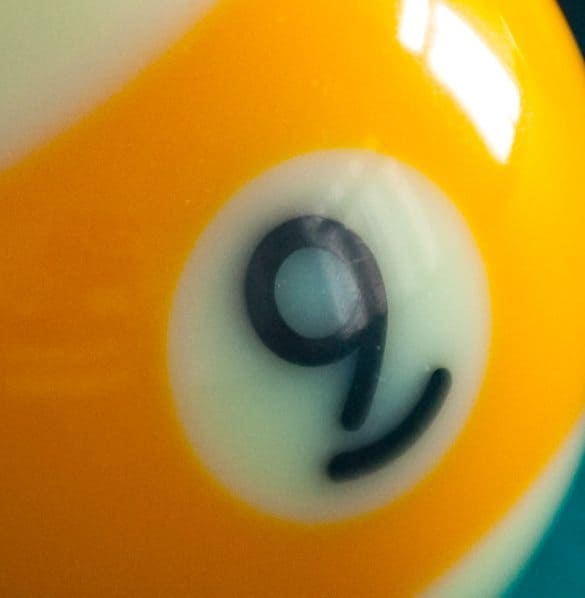
100% crop of the Billiard Ball shot at F2.0
For comparison, I shot the same ball with a Canon EF 50mm F1.2 L lens at the same aperture, F2.0. The Lensbaby is said to have a focal lens of around 50mm too, which is why I chose the Canon 50mm to compare it with. Both shots were made hand held, and I actually changed the ISO to 200 for the below shot, because you get a little bit of light drop off with the Lensbaby as you twist it off center, but I wanted to keep a similar shutter speed. This means though that there is no grain to speak of in this image. You can see that the overall look is a tad softer with the Canon lens. There’s definitely a nice quality to the Canon 50mm image, but it shows that the Lensbaby Composer is definitely as sharp as its competitors in that sweet-spot, if not sharper.
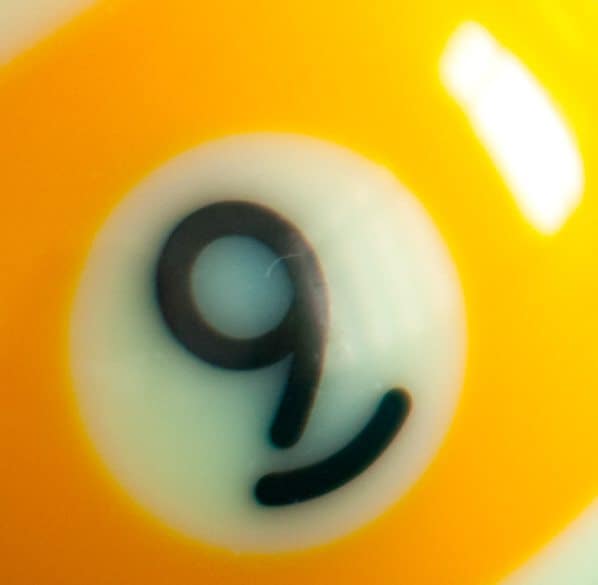
100% crop shot with a Canon EF 50mm F1.2 L lens at F2.0
Let’s move on now to some other example images that I’ve been capturing since getting my Lensbaby. Next up is image number 2297 (below), that I shot in a small town way up north called Joboji. I took a drive up a country road that I found on my last visit, and noticed this abandoned shack in the woods. Now I have to admit, I am still sometimes turning to the Lensbaby as a means to an end, rather than it being my first choice. I have to really embed it in my work-flow before I can truly work with this lens. Here though, there was a thick black power cable running across the top of the scene. You can just about see it in the blur, running from the top right corner, down past the top of the shack just before the blue of the sky starts, then down to about a third of the way into the image from the top as it makes its way to the left of the frame.

Shack in Woods (Lensbaby @ F5.6)
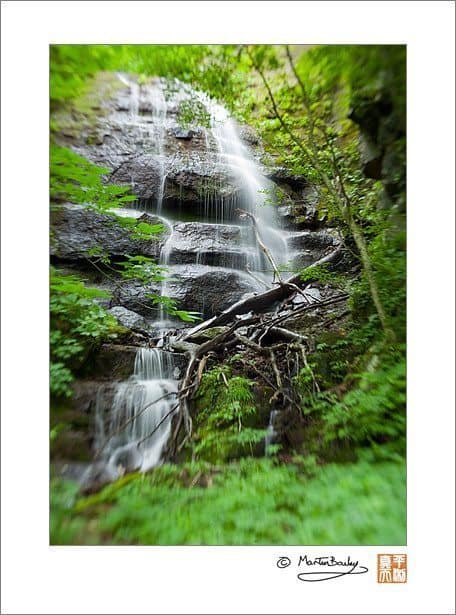
Kudan (Nine Steps) Falls (Lensbaby @ F11)
I reached for the Lensbaby Composer, as I knew that it would help me to make the cable go away. I used the F5.6 aperture ring, for a wider sweet-spot, which I aligned with the side of the shack and a little of the foreground. This gave me a pretty eary image, with the trees in front of the shack, and the tree trunk and foliage to the left running out of the frame nicely. I was pretty pleased with the result, and pleased that the cable made me think of the Lensbaby.
I’d shot some other images between the previous one and the next we’ll look at, and I’ll put a link in the show-notes to show not only all the Lensbaby images I’ve made so far, but it will also pick up everything I shoot from now on as well. Next though, image 2311 (right), is another image where the subject demanded that I use the Lensbaby. I found these falls just off the track as I walked along the Oirase Mountain Stream recently, but there were these fallen logs and branches in the front of the falls, and I was not entirely impressed with the surroundings.The foreground was boring, and I just didn’t think it would work ‘straight’. I used the F11 aperture ring for a very wide sweet spot, as I really wanted to blur just the outer edges of the image. I also wanted a longer shutter speed, and F11 helped me to get to 3/5 of a second. I’m pretty pleased with the resulting image, and again, I think the Lensbaby helped me to make something of what I would otherwise have walked away from.
The last example image that I wanted to look at is of the Oirase Mountain stream itself, in image number 2314 (below, right). Here I was standing with my tripod legs perched precariously on three separate rocks, with the camera standing over the fast flowing water. Probably not the best spot to change out lenses, but I decided to try a shot of this with the Lensbaby before I moved on. Again, using the F11 aperture ring, I think I also held an ND8 neutral density filter in front of the lens here to give me a 4/5 of a second exposure at ISO 100. I may have done that for the last shot as well, but I’m not sure. Anyway, again here the large sweet spot has given us lots of the scene in focus, but the outer edges are all blurry, giving us a nice creative feel to the image.

Oirase Mountain Stream (Lensbaby @ F11)
So, to summarize my overall impressions of the Lensbaby composer, on the plus side, I really like the way you can now focus the Lensbaby with a focus ring, like a traditional lens, and the focus mechanism is totally separate from the adjustment of the sweet spot. I have both the Lensbaby 1.0 and 2.0, though I skipped the 3rd generation War of the Worlds model. I never liked the fact that you had to keep your hands on the 1st and 2nd generation lensbabies though, both to focus them and to adjust the position of the sweet-spot. All of that is behind me now though, with the Lensbaby Composer, and as I say, with the new double glass optics, the Lensbaby Composer is tack-sharp in that sweet-spot. The addition of the sturdy little lens case, albeit an optional purchase, also adds a lot to the overall usefulness of the lens. I can drop it into the inside pocket of my photographer’s vest, so it’s always with me.
I only have a couple of very small little peeves, though for the price I am more than satisfied. One thing is that when you turn the locking ring to lock the front of the lens in place, it sends the focus off. If it held focus when locking it down, it would almost be a little too good. I’m finding that I’m applying just enough tension with the locking ring to stop the front of the lens from flopping around, but not so much that I can’t move it, and just leave it like that.
The other thing is more an enhancement request than a problem, but I’d really like the Composer’s optional lens case to have a belt loop. It’s great as it is, but with a belt loop I could have quick and easy access to the Lensbaby Composer while walking around town or on location etc.
Apart from these two tiny things though, having now used the Lensbaby Composer in the field for a while, it’s still a big thumbs up. With the new optics, this really is now ready for the serious photographer that wants his or her images to be tack sharp where they need to be, but still being able to have fun with the overall creativity of this wacky little lens.
Podcast show-notes:
Music from Music Alley: http://www.musicalley.com/
Audio
Subscribe in iTunes for Enhanced Podcasts delivered automatically to your computer.
Download this Podcast in MP3 format (Audio Only).
Download this Podcast in Enhanced Podcast M4A format. This requires Apple iTunes or Quicktime to view/listen.


Wie immer… lesenswerter Post. Sorry dass ich mich nie beteilige, auch wenn ich dauernd hier lese.
Another Excellent blog post, I will save this post in my Del.icio.us account. Have a good day.